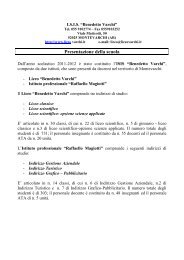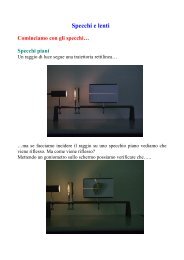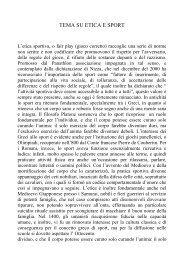La retta nel piano cartesiano - Liceo Varchi
La retta nel piano cartesiano - Liceo Varchi
La retta nel piano cartesiano - Liceo Varchi
Create successful ePaper yourself
Turn your PDF publications into a flip-book with our unique Google optimized e-Paper software.
- <strong>retta</strong> -<br />
Equazione della <strong>retta</strong> passante per due punti assegnati<br />
Supponiamo di volere trovare l’equazione della <strong>retta</strong> passante per A ( 2;<br />
3)<br />
e B ( 6;<br />
5)<br />
.<br />
Osserviamo che possiamo ricavare il coefficiente angolare della <strong>retta</strong> partendo dal triangolo<br />
tratteggiato in figura:<br />
yB<br />
− y A<br />
m =<br />
x − x<br />
10<br />
B<br />
1<br />
e <strong>nel</strong> nostro esempio m = .<br />
2<br />
A questo punto possiamo utilizzare l’equazione della <strong>retta</strong> per A, per esempio, con coefficiente<br />
1<br />
1<br />
angolare m = : y − 3 = ( x − 2)<br />
2<br />
2<br />
In generale l’equazione della <strong>retta</strong> passante per A ( x A; y A ) e B ( xB<br />
; yB<br />
) avrà equazione:<br />
che può essere anche scritta<br />
y − y<br />
y − y<br />
B<br />
y B − y A<br />
y − y A = ⋅ ( x − x A )<br />
x − x<br />
A<br />
A<br />
x − x A<br />
= .<br />
x − x<br />
B<br />
A<br />
B<br />
Nota: se per ricavare m ci si affida al <strong>piano</strong> quad<strong>retta</strong>to occorre fare attenzione ai coefficienti angolari<br />
negativi.<br />
Per esempio le misure dei cateti del triangolo<br />
tratteggiato sono ancora 2 e 4 ma in questo caso è chiaro<br />
1<br />
che m = − .<br />
A<br />
A<br />
2<br />
y<br />
Infatti m<br />
=<br />
x<br />
B<br />
B<br />
−<br />
−<br />
y<br />
x<br />
A<br />
A<br />
4 − 2 1<br />
= = −<br />
− 5 + 1 2









